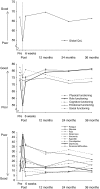The impact of radiotherapy late effects on quality of life in gynaecological cancer patients
- PMID: 19384297
- PMCID: PMC2696756
- DOI: 10.1038/sj.bjc.6605050
The impact of radiotherapy late effects on quality of life in gynaecological cancer patients
Abstract
The aims of this study were to assess changes in quality of life (QoL) scores in relation to radical radiotherapy for gynaecological cancer (before and after treatment up to 3 years), and to identify the effect that late treatment effects have on QoL. This was a prospective study involving 225 gynaecological cancer patients. A QoL instrument (European Organisation for the Research and Treatment of Cancer QLQ-C30) and late treatment effect questionnaire (Late Effects Normal Tissues - Subjective Objective Management Analysis) were completed before and after treatment (immediately after radiotherapy, 6 weeks, 12, 24 and 36 months after treatment). Most patients had acute physical symptoms and impaired functioning immediately after treatment. Levels of fatigue and diarrhoea only returned to those at pre-treatment assessment after 6 weeks. Patients with high treatment toxicity scores had lower global QoL scores. In conclusion, treatment with radiotherapy for gynaecological cancer has a negative effect on QoL, most apparent immediately after treatment. Certain late treatment effects have a negative effect on QoL for at least 2 years after radiotherapy. These treatment effects are centred on symptoms relating to the rectum and bowel, for example, diarrhoea, tenesmus and urgency. Future research will identify specific symptoms resulting from late treatment toxicity that have the greatest effect on QoL; therefore allowing effective management plans to be developed to reduce these symptoms and improve QoL in gynaecological cancer patients.
Figures



Similar articles
-
The Impact of Age on Quality of Life in Breast Cancer Patients Receiving Adjuvant Chemotherapy: A Comparative Analysis From the Prospective Multicenter Randomized ADEBAR trial.Clin Breast Cancer. 2017 Apr;17(2):100-106. doi: 10.1016/j.clbc.2016.10.008. Epub 2016 Oct 19. Clin Breast Cancer. 2017. PMID: 27884722
-
A modified Inflammatory Bowel Disease questionnaire and the Vaizey Incontinence questionnaire are simple ways to identify patients with significant gastrointestinal symptoms after pelvic radiotherapy.Br J Cancer. 2005 May 9;92(9):1663-70. doi: 10.1038/sj.bjc.6602552. Br J Cancer. 2005. PMID: 15856043 Free PMC article.
-
The impact of radiotherapy on quality of life for cancer patients: a longitudinal study.Support Care Cancer. 2014 Sep;22(9):2479-87. doi: 10.1007/s00520-014-2235-y. Epub 2014 Apr 12. Support Care Cancer. 2014. PMID: 24728584
-
Quality of life study in prostate cancer patients treated with three-dimensional conformal radiation therapy: comparing late bowel and bladder quality of life symptoms to that of the normal population.Int J Radiat Oncol Biol Phys. 2001 Jan 1;49(1):51-9. doi: 10.1016/s0360-3016(00)01365-1. Int J Radiat Oncol Biol Phys. 2001. PMID: 11163497 Review.
-
Quality-of-life considerations in the treatment of early-stage breast cancer in the elderly.Drugs Aging. 2010 Oct 1;27(10):791-800. doi: 10.2165/11584700-000000000-00000. Drugs Aging. 2010. PMID: 20883059 Review.
Cited by
-
Personalized radiotherapy: concepts, biomarkers and trial design.Br J Radiol. 2015 Jul;88(1051):20150009. doi: 10.1259/bjr.20150009. Epub 2015 May 20. Br J Radiol. 2015. PMID: 25989697 Free PMC article. Review.
-
The impact of gynaecological cancer treatment on physical activity levels: a systematic review of observational studies.Braz J Phys Ther. 2019 Mar-Apr;23(2):79-92. doi: 10.1016/j.bjpt.2018.11.007. Epub 2018 Nov 17. Braz J Phys Ther. 2019. PMID: 30473435 Free PMC article.
-
Towards Personalized Radiotherapy in Pelvic Cancer: Patient-Related Risk Factors for Late Radiation Toxicity.Curr Oncol. 2025 Jan 17;32(1):47. doi: 10.3390/curroncol32010047. Curr Oncol. 2025. PMID: 39851963 Free PMC article. Review.
-
Structured gastroenterological intervention and improved outcome for patients with chronic gastrointestinal symptoms following pelvic radiotherapy.Support Care Cancer. 2013 Aug;21(8):2255-65. doi: 10.1007/s00520-013-1782-y. Epub 2013 Mar 21. Support Care Cancer. 2013. PMID: 23512314
-
A Randomized Controlled Trial on Pranayama and Yoga Nidra for Anxiety and Depression in Patients With Cervical Cancer Undergoing Standard of Care.Cureus. 2024 Mar 9;16(3):e55871. doi: 10.7759/cureus.55871. eCollection 2024 Mar. Cureus. 2024. PMID: 38595893 Free PMC article.
References
-
- Aaronson NK, Ahmedzai S, Bergman B, Bullinger M, Cull A, Duez NJ, Filiberti A, Fletchtner H, Fleishman SB, De Haes JCJM, Kaasa S, Klee M, Osoba D, Razavi D, Rofe PB, Schraub S, Sneeuw K, Sullivan M, Takedan F (1993) The European Organization for Research and Treatment of Cancer QLQ-C30: a quality-of-life instrument for use in international clinical trials in oncology. J Natl Cancer Inst 85: 365–376 - PubMed
-
- Andreyev J (2007) Gastrointestinal symptoms after pelvic radiotherapy: a new understanding to improve management of symptomatic patients. Lancet Oncol 8: 1007–1017 - PubMed
-
- Bentzen SM, Dorr W, Anscher MS, Denham JW, Hauer-Jenson M, Marks LB, Williams J (2003) Normal tissue effects: reporting and analysis. Semin Radiat Oncol 13: 189–202 - PubMed
-
- Bergmark K, Avall-Lundqvist E, Dickman PW, Henningsohn L, Steineck G (1999) Vaginal changes and sexuality in women with a history of cervical cancer. N Engl J Med 340: 1383–1389 - PubMed
-
- Bradley S, Rose S, Lutgendorf S, Costanzo E, Anderson B (2006) Quality of life and mental health in cervical and endometrial cancer survivors. Gynecol Oncol 100: 479–486 - PubMed
Publication types
MeSH terms
LinkOut - more resources
Full Text Sources

